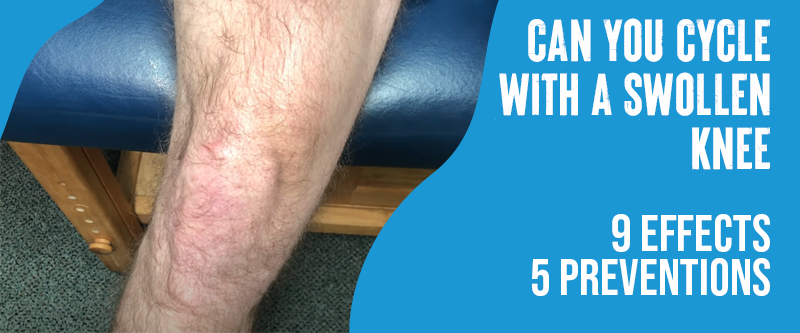Cycling with a swollen knee can worsen your joint condition and lead to further damage and pain. The pressure exerted on the knee joint with each pedal stroke can cause significant discomfort and aggravate the swelling.
This can cause inflammation and further swelling, leading to chronic pain, decreased mobility, and a reduced quality of life. It is best to avoid cycling when experiencing a swollen knee.
It is not recommended to continue cycling. It’s crucial to allow the knee time to rest and heal before resuming cycling, and seeking medical advice is highly advised to determine the severity of the swelling and the suitability of cycling for recovery.
This article will explore the potential consequences of cycling with a swollen knee, including pain, delayed healing, and increased injury risk. Learn preventive tips to protect your knees and ensure safe cycling.
Can You Cycle With a Swollen Knee: 9 Effects
When you have a swollen knee, it is crucial to understand the potential effects cycling can have on your knee. Here are 9 effects that you should know about:
Increased Pain and Discomfort
Swollen knees can cause increased pain and discomfort in the affected area. Cycling puts pressure on the knee joint and surrounding tissues, aggravating the swelling and worsening the pain. Swelling can also cause stiffness, making it harder to cycle and increasing the discomfort.
Delayed Healing
The use of cycling equipment while the knee is swollen can delay the healing process, slowing recovery. Exercising with a swollen knee can exacerbate the swelling and intensify the pain, prolonging the healing period and increasing the risk of further injury or complications.
Further Damage
Exercising can increase the risk of further injury to the knee when your knee is swollen. The pressure and strain put on the joint during cycling can cause additional damage to the weakened tissues or ligaments surrounding the knee joint, leading to more pain and swelling.
Compromised Balance
When cycling with a swollen knee, your balance may be compromised, making it challenging to maintain proper form. As a result, you may favor one leg over the other, leading to incorrect posture, which can cause misalignment in different body areas.
Increased Anxiety and Stress
A swollen knee when cycling can increase your anxiety and stress levels. Pain and discomfort from swelling can cause emotional distress, leading to increased anxiety and stress that can affect your mental health.
Negative Impact on Overall Health
Swollen knees can hurt your overall health. You can suffer from mental health problems and increase your risk of further injury. When you cannot exercise, it can affect your mood and hinder your ability to maintain a healthy lifestyle.
Increased Risk of Injury
Cycling on a swollen knee can increase the risk of injury in the knee joint. It can cause instability, leading to further damage, and may cause severe pain to the individual.
Increased knee popped and swollen
A popped and swollen knee can significantly influence your ability to cycle. This condition usually indicates an acute injury, often caused by a sudden strain or movement during physical activities like cycling. Continuing to cycle with such an injury could exacerbate the issue.
Increased Stiffness
Cycling with a swollen knee can lead to increased stiffness in the joint, potentially exacerbating any underlying conditions and causing further discomfort. This swelling can often be a symptom of common cycling-related knee injuries such as patella chondromalacia and Iliotibial Band Syndrome.
Aspects of Cycling With a Swollen Knee
Swollen knees can be tricky, especially for cyclists. Inflammation, damage, or another issue can cause swelling in the knees. Here are some of the various aspects of cycling with a swollen knee, considering scenarios such as swollen knee and ankle, swollen broken knee, and a knee that is both swollen and warm.
Swollen Knee and Ankle
Swelling in the ankle and knee can result from various conditions, such as arthritis, ligament injuries, or overuse. Before deciding to cycle with a swollen knee, it is crucial to identify the underlying cause of the swelling.
Consultation with a medical professional will help determine the severity of the condition and provide guidance on whether cycling is a suitable activity.
Swollen Broken Knee
Cycling may not be advisable during the initial stages of recovery from a swollen, broken knee. Broken bones require adequate time to heal, and engaging in activities like cycling too soon can exacerbate the injury.
Symptoms of Swollen Knees In Cyclists
A swollen knee can be a significant setback for cyclists. However, recognizing the symptoms understanding can help you manage this condition and get back on your bike safely. You may encounter several symptoms when dealing with a swollen knee:
- Pain: The first sign that you might notice is pain. It could be a slight discomfort while pedaling or a more severe ache that hinders your cycling altogether.
- Swelling: Your knee might appear more prominent or puffier than usual. This swelling can limit your knee’s mobility and make it challenging to ride your bike as you normally would.
- Stiffness: A swollen knee can often become stiff, making it hard to bend it effectively during your cycling routine.
- Redness: In some cases, the swollen area might also turn red, indicating inflammation or infection. This could make your cycling sessions uncomfortable and require medical attention.
Diagnosing a Swollen Knee in Cyclists
Getting an accurate diagnosis is crucial if you’re experiencing any of these symptoms. Your healthcare provider will likely begin with a detailed history and physical examination to understand the cause of your symptoms. They’ll ask about your cycling habits, any injuries you might have had, and your general health.
After this initial assessment, you might need to undergo some tests to determine the root cause of your swollen knee. These tests could include:
- X-ray: An X-ray can reveal your knee joint, revealing any irregularities, such as fractures or signs of arthritis, that could cause the swelling.
- MRI: An MRI (Magnetic Resonance Imaging) offers a more in-depth view of your knee. It can show damage to the soft tissues around your knee, such as ligaments and tendons, which might contribute to the swelling.
Cycling with a Swollen Knee: Different Positions
Outer Knee Swelling
Swelling on the outside of your knee can be troublesome while cycling. It can restrict your movement and cause considerable discomfort. In such cases, it’s crucial to consult a healthcare professional to understand the underlying cause of the swelling and receive treatment. Meanwhile, you can adjust your leg position while cycling. For instance, keeping your leg slightly bent instead of fully extended can help reduce pressure on the swollen area.
Inner Knee Swelling
A swollen inner knee can also pose challenges while cycling. The key here is to avoid putting too much weight on the affected knee. Adjusting your seat to a higher position allows you to extend your leg more fully, reducing pressure on the inner knee. Also, consider using a knee brace or compression bandage to provide extra support and ease pain.
Bend Your Knee
A swollen knee that can’t bend can make cycling extremely difficult. In such cases, it might be best to pause your cycling routine until the swelling subsides. However, if you still wish to continue, consider cycling slowly on a flat surface. Remember to listen to your body and stop if you experience severe pain or discomfort.
Side Knee Swelling
Various factors, such as an injury or overuse of the knee joint, can cause side knee swelling. If you’re dealing with side knee swelling, taking it easy and not pushing yourself too hard is important. Consider reducing your cycling speed and distance until the swelling decreases. Applying a cold pack to the swollen area can help reduce inflammation and relieve pain.
Cycling With A Swollen Knee: Tips For Reducing It
A swollen knee can be a significant setback for those who love cycling. But does a swollen knee mean you have to give up cycling? Well, the answer is only sometimes a simple yes or no. It depends on what caused your knee to swell and how bad it is. This article will guide you on dealing with knee swelling and getting back on your bike.
- Rest: Give your knee some time off. Resting allows your body to heal and prevents more strain on your knee.
- Ice or Heat for a Swollen Knee: Ice reduces inflammation and should be used initially, while heat promotes blood flow and is effective once the initial swelling has gone down in knee swelling management.
- Compression: Wrap your knee with an elastic bandage. Reduction can control swelling by preventing fluid buildup.
- Elevation: Lift your knee. This helps the fluid drain away from your knee.
- Medication: Over-the-counter anti-inflammatory medications can help lessen swelling and pain.
Natural Remedies for Knee Swelling
Natural remedies can also help manage knee swelling:
- Turmeric: Turmeric is known for its anti-inflammatory properties and can be taken orally or applied topically.
- Ginger: Ginger is a versatile ingredient that offers many health benefits. The herb has potent anti-inflammatory properties and can be consumed as tea, juice, or spice.
- Epsom Salt Bath: Soaking your knee in an Epsom salt bath can help ease swelling and pain.
Treatment of knee swelling associated with osteoarthritis in cyclists
Osteoarthritis, a common cause of knee swelling, usually affects older adults. It occurs when the knee joint wears down. If you have osteoarthritis, cycling could worsen your symptoms if not appropriately managed. Here are some treatment options for osteoarthritis-related knee swelling:
- Weight Management: Extra weight puts more stress on your knee joints. So, maintaining a healthy weight can help alleviate symptoms of osteoarthritis.
4 Cycling Knee Pain Prevention
For some athletes, this sport can lead to knee pain because of overuse or injury. Knowing how to prevent further damage or discomfort while cycling is essential if you have a swollen knee. Here are some prevention measures that can help:
Focus on the Pedal Stroke
Observe the pros in action; you’ll immediately notice their smooth and swift pedal strokes. Enhance your pedal stroke with this effective drill: When tackling your favorite climb, opt for a gear at least two teeth lower, making it easier on your joints. Focus on pedaling in circular motions rather than ovals, ensuring optimal efficiency and power.
Warm Up
Like any other sport, warming up is essential in cycling to get your blood flowing and muscles ready for the activity. Doing 15 minutes of moderate spinning before trying a local climb or going hard on the flats is recommended.
Build Mileage Gradually
After taking an extended break, avoiding jumping right into a five-hour ride is essential. Instead, begin with a shorter distance and accumulate your mileage. With this approach, you can ensure a smoother and more effective return to your riding routine.
Beware of Change
Consistency is vital to your body’s happiness. When you make equipment changes, your knees might voice their discontent. Whether you switch up your bike, shoes, or pedals or alter the stem length, take it slow initially to allow yourself time to adapt and find your stride.
Knee Braces or Supports
If you experience knee pain while cycling, wearing a knee brace or support can be beneficial. It can offer additional support and stability to your knee, which can help reduce stress on the joint and ease discomfort during your ride.
3 Exercises for Cycling Knee Pain
Cycling provides an excellent means of staying fit and healthy. However, knee pain can be a significant obstacle to enjoying the sport to its fullest.
A swollen knee can make cycling more challenging, but various exercises can help ease the pain and enhance your overall cycling experience. Here are some exercises that you can use to keep cycling knee pain away:
Knee Strengthening Exercises
Strengthening the muscles surrounding the knee joint may be necessary to ease pain and improve joint stability. A few exercises you can perform are:
- Leg Press: This exercise strengthens the thigh muscles, which can help ease pressure on the knee joint.
- Quad Sets: Put your legs straight out before you and contract your thigh muscles. Hold for a few seconds and release. Repeat 10-15 times.
- Step-Ups: Jump on a low platform and back down. Repeat with the other foot.
Knee Flexibility Exercises
Flexibility exercises help reduce stiffness and improve range of motion. The following exercises can be performed:
- Hamstring Stretch: Lie on the floor and stretch your legs out straight. Try touching your toes by reaching forward. Hold for 30-60 seconds.
- Calf Stretch: Stand about arm’s length away from a wall. Stand with your hands on the fence and step back, pressing your heel into the ground. Hold for 30-60 seconds. Repeat with the other foot.
- Quadriceps Stretch: Stand on one foot and lift your foot towards your buttocks. Pull your foot toward your buttocks while holding your ankle with your hand. Hold for 30-60 seconds.
Low-affected Exercises for Knee Pain
If you’re experiencing knee pain, engaging in low-affected exercises to reduce pressure on the knee joint is essential. Here are a few exercises you can do:
- Cycling: Cycling is an excellent low-affected exercise option that can help improve knee mobility and reduce pain.
- Swimming: Swimming focuses on the entire body with little stress on the joints, making it an excellent option for those with knee pain.
- Yoga: Yoga helps you stay flexible while reducing knee joint stress.
Conclusion
Cyclists often complain about knee pain, but it does not have to keep you from enjoying the activity you love. While cycling with a swollen knee might be possible under certain circumstances, seeking medical advice and following preventive measures is crucial to minimize the risk of further injury.
Cycling can be beneficial for taking care of your knees while lowering the likelihood of cycling knee pain. Remember to stretch before cycling, use proper bike fitting, and allow enough recovery time between cycling sessions. Stay safe, and enjoy your ride.
FAQs
Can I Massage a Cycle With A Swollen Knee?
No, massaging a swollen knee can increase inflammation in the joint and cause further damage. It is recommended to avoid massaging and seek medical advice.
Cycling Can Be Good For Your Knees?
The movement of your legs pushing on the pedals can help reduce pain or stiffness. Cycling can also improve the range of motion in your knees, so you might benefit from cycling if you have pain and stiffness.
Does Cycling Strengthen Knee Ligaments?
While exercising on a bicycle, quadriceps rehabilitation is achieved, and stress on the knee ligaments is controlled. Pedaling places forces on the anterior cruciate ligament, the capsular ligaments, and the posterior structures of the knee joint.






